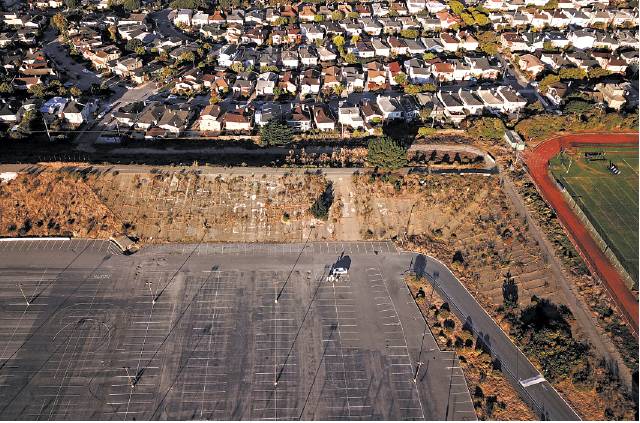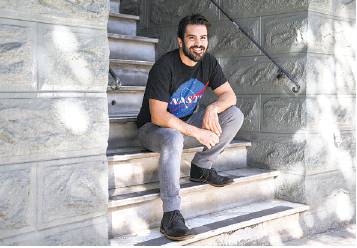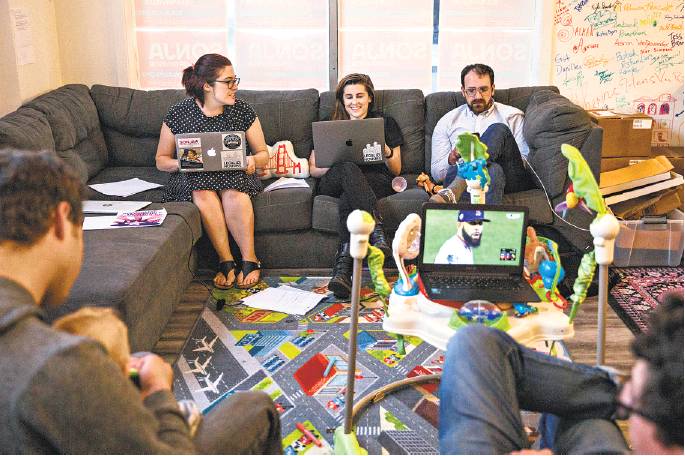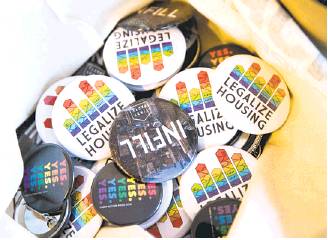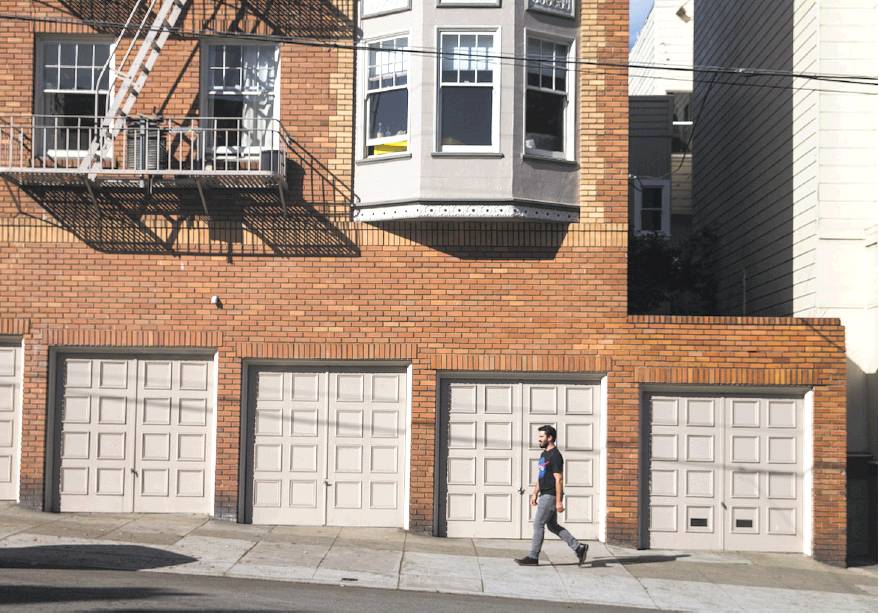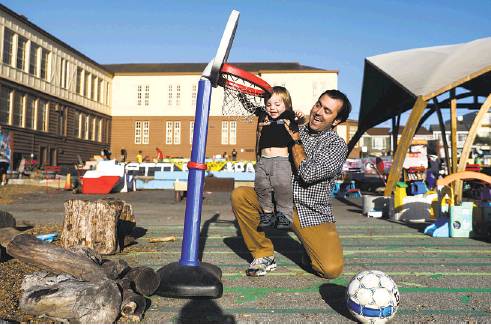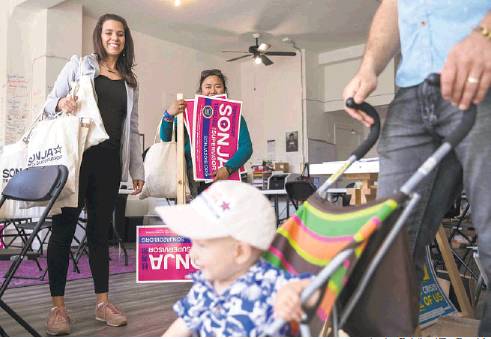BAY AREA HOUSING CRISIS
Pro-housing force gains power, foes
YIMBY movement will face big test of its agenda Tuesday across Bay Area
By J.K. DineenJust hours after Mayor London Breed was sworn into office earlier this year, about 50 members of YIMBY Action crammed into a cafe at Ninth and Mission streets for their monthly membership happy hour.
They drank complimentary beer and wine, provided by the building’s owner, developer Patrick Kennedy. The group’s executive director, Laura Foote Clark, asked the crowd how many had attended Breed’s inauguration. About a dozen hands shot up.
“It has been an incredibly amazing day,” Foote Clark said. “I want everyone to think about today — about this moment in time — as a major shift. We are finally seeing our government treating the housing shortage as an emergency. We are going to start seeing some real changes.”
The elevation of Breed — a powerful ally in San Francisco City Hall — was a watershed moment for the YIMBYs, the San Francisco-bred “yes in my backyard” movement that in less than four years has progressed from a few people plastering telephone poles with pro-housing fliers to an organization with 2,100 local dues-paying members. It has local chapters in a dozen San Francisco neighborhoods, 140 chapters around the country and world and lobbyists in Sacramento.
This week, the YIMBYs’ pro-housing revolution is facing perhaps its biggest test. Its agenda is all over the Nov. 6 ballot. YIMBY-bred candidates are running for office in San Diego, Mountain View, Palo Alto, Oakland and other cities. YIMBY-supported measures will be voted on in dozens of cities across the state.
In San Francisco, four Board of Supervisors candidates are card-carrying YIMBYs: movement pioneer Sonja Trauss in District Six, Theo Ellington in District 10, Trevor McNeil in District Four and Nick Josefowitz in District Two.
“Politicians are taking the YIMBYs’ energy and running with it,” said Jason McDaniels, a professor of political science at San Francisco State University.
Some of the YIMBYs’ biggest Bay Area battles will be decided in this election. Brisbane voters will decide whether to allow up to 2,200 units of housing on the 665-acre Baylands property just south of the San Francisco border. The group made the development a pet cause, showing up en masse at City Council meetings and drawing crucial support from sympathetic state lawmakers.
Matt Regan, senior vice president of policy for the Bay Area Council, a regional business association, said YIMBY advocacy also played a key role in another battle over housing density, pressuring Cupertino City Council in September to allow 2,900 housing units on the site of the failed Vallco shopping mall.
“I’ve been doing housing advocacy for 12 years, and for nine of those 12 years it was me, the developer and a bunch of angry old NIMBYs showing up at hearings,” said Regan. “Since the growth of the YIMBYs, it’s me, the developer, a bunch of angry old people and a bunch of angry young people.”
In Brisbane and Cupertino, he said, the YIMBYs “opened the eyes of local government officials that there is a large community out there that is not benefiting from the status quo.
“They feel the Bay Area is not a place they have a future,” Regan said. “They are mad as hell and doing something about it.”
* * *
The heart of the YIMBY San Francisco operation is a messy storefront on Mission Street near Ninth. For the past six months, the office has been home to YIMBY Action, Trauss’ campaign and CaRLA — California Renters Legal Advocacy and Education Fund — a YIMBY affiliate that sues communities, often in the suburbs, for blocking housing in violation of state law.
It shares the building with a cannabis dispensary, and frequently someone will wander in looking to make a pot purchase.
“I give them the housing pitch and they look confused,” Foote Clark said. “I don’t let them out of here without some literature. The new flier has a smiling Muni bus on it — weed people should like that!”
On a Friday evening last month, about a dozen YIMBYs were sprawled on beat-up couches, laptops in front of them. Campaign signs were stacked against the wall. Piled on a front desk were stickers, buttons and posters with sayings like “Legalize Housing” and “Neighbors for More Neighbors.”
Trauss, exhausted from hours of canvassing apartment buildings, flopped on a couch. Other volunteers were coordinating campaign work over the Slack messaging network. YIMBY Action organizes primarily online: It oversees 85 public Slack channels, on which an average of 875 messages are shared each day. On Twitter, there are at least that many YIMBY-related postings in a given day.
* * *
All this activity came about because of the blossoming of jobs, mostly in technology, that grew out of the wreckage of the Great Recession. Before the economic downturn in 2008, the city had already shown signs of becoming an urban alternative to Silicon Valley, not just for startups but for established businesses like Google, which found that a San Francisco address helped with recruiting.
The city saw a 71 percent increase in tech jobs between 2010 and 2015. Salesforce decided to focus growth in the city. The new crop of tech companies — Twitter, Yelp, Dropbox, Square, Reddit, Airbnb, Lyft, Uber and others — all located in the city.
These companies found plenty of office space. But the new workers were less fortunate when it came to housing. Between 2010 and 2015, San Francisco produced one new housing unit for every 8.2 new jobs. The Bay Area as a whole was only slightly better, creating one unit for about every six jobs. The imbalance helped drive up housing costs in a region already among the most expensive in the country:
The median house in the city now costs $1.62 million, double what it did five years ago.
The average sale price of a house in San Francisco rose by $205,000 in the first half of 2018, the largest six-month increase in history, according to real estate agency Paragon.
About 66 percent of homes in the city are valued at more than $1 million.
Only 18 percent of Bay Area residents can afford a median-priced home.
To YIMBYs, the reason for the housing crisis is simple: Decades of restrictive zoning laws and political obstacles have led to a dramatic underproduction of housing.
Multifamily development is essentially illegal on 90 percent of the land in many Bay Area suburbs. Even in dense San Francisco, 72 percent of the land where housing is allowed is restricted to single-family homes. The down-zoning of city neighborhoods — much of it in the early 1980s on the west side of San Francisco — has left a new generation of urban dwellers with scant affordable rental or home-buying options.
YIMBYs advocate for relaxing zoning to allow for taller, denser buildings, and for eliminating community planning processes that allow residents to block, delay or reduce the size of developments. They bristle at most of the reasons longtime residents cite for opposing new housing: neighborhood charm and character, increases in traffic or lack of parking.
On the campaign trail in his development-averse Sunset District neighborhood, McNeil, a public school teacher with three small children, illustrates his YIMBY philosophy by pulling up an early 1930s picture of rolling sand dunes on his iPhone. It’s an image of 28th Avenue, at exactly the spot the home he rents now stands.
“When that house was built it added to the congestion and density and traffic, and I assume it disrupted the character of the neighborhood,” he says. “Now it’s a classic Sunset house. I live there with my family. I’m grateful that someone had the audacity to build it.”
Critics say the YIMBYs’ “build, baby, build” approach is ham-fisted and simplistic. Some characterize them as pawns of gentrifying developers, preaching an urbanist ideology that gives political cover to profit-driven builders whose towers attract high-earning residents and fuel the displacement of existing communities.
Others say YIMBYs are disdainful of the history and character that make San Francisco unique. YIMBYs, they charge, are perfectly willing to kill the city’s spirit to provide housing for high-income tech workers. Trauss has called neighborhood character “a cancer.”
“All the things we cherish as San Franciscans, they never mention,” San Francisco Planning Commissioner Dennis Richards said. “They ... don’t seem to appreciate what it is about San Francisco that makes it special and how we might grow while maintaining that.”
At public meetings, Trauss and Foote Clark and supporters regularly show up to speak in favor of projects. They also have disparaged neighbors opposed to development: On Twitter, YIMBYs have called Coalition of San Francisco Neighborhoods President George Wooding a “wealthy, west side homeowner with too much time on his hands.”
“Rather than extending an olive branch and sitting down to talk about how we can achieve more density, the YIMBYs’ approach has always been about confrontation,” said Wooding, a Midtown Terrace resident. “The west side is always getting punched in the mouth by YIMBY. We are supposed to be pilloried because we don’t want to have a 60-foot (tall) building besides a 26-foot home?”
This confrontational style has alienated even some residents who consider themselves pro-housing.
In 2015, Jim Worshell, president of the Hayes Valley Neighborhood Association and the San Francisco Victorian Alliance, invited several YIMBYs to a meeting. He said YIMBY organizer Brian Hanlon told the assembled neighbors: “We can’t wait for you to die and rip those pretty Victorians down.”
“That was their message: ‘I don’t care about preservation or you people with those old Victorians. It’s our time now and you should die. You are in the way,’ ” Worshell said.
Hanlon, now the head of California YIMBY, said he doesn’t remember the meeting or saying such a thing.
“I’ve said some dumb things, but I doubt I said that,” he wrote in a text. “I actually like lots of the old Victorians.”
S.F. State professor McDaniels said though the movement has matured, it remains “disruptive.”
“They don’t do things to make friends with the establishment,” he said. “They can be abrasive. They don’t apologize.”
* * *
Trauss, a Philadelphia native and self-described anarchist, came to the Bay Area in 2011 to help care for a sick relative. Having recently left the economics Ph.D. program at Washington University in St. Louis, she found work teaching high school and college math. She bounced from rental to rental, living in El Cerrito, West Oakland and then SoMa in San Francisco.
As the new tech boom began to take shape, Trauss struggled to find an affordable place to live. Open houses for apartments were mobbed; rent and transportation costs were eating up more than 50 percent of her income.
Trauss saw the problem as a deficit of new housing, so she started paying attention to things like zoning, height limits and land-use politics. She attended marathon Planning Commission meetings where residents lined up to oppose new housing units for seemingly every reason imaginable — shadows, neighborhood character, parking, traffic, gentrification, historic preservation, displacement.
The result, she found, was always the same: “Which is the building doesn’t get built,” Trauss said. “And if the building doesn’t get built, where are those people going to live? They are going to live in West Oakland.
“They are going to force out lower-income people, whether that’s in the Mission, Potrero or West Oakland,” she said. “Or the Tenderloin. Or North Beach.”
Trauss felt there was an untapped constituency of frustrated, pro-housing renters in the city. She thought if she could convince those people to speak out, the debate over housing production would become more balanced.
She started recruiting like-minded commenters from real estate-focused websites like Socketsite and Curbed and badgering them to attend public hearings. She created a mailing list and eventually founded the San Francisco Bay Area Renters Federation — SFBARF.
SFBARF started putting posters up around the city. The first were focused on Balboa Reservoir, a 17-acre, publicly owned parking lot next to City College. The posters read: “Housing Crisis? San Francisco needs all 6,000 units at the Balboa Reservoir. Tell the Planning Department In Person.”
A poster about the “Monster In the Mission” development at 16th and Mission streets said: “When we were promised 40: what’s the point in 10 stories?” Another, about a proposed project at 75 Howard St., read: “Go Big Or I Can’t Go home.”
Almost immediately, Trauss and her supporters became pariahs in some San Francisco progressive camps. The group Gay Shame put out its own poster, proclaiming “S.F. barfs on Sonja Trauss” and calling her the “grand marshal ... of a big development-backed hit squad.”
That was news to developers, who were initially skeptical of the group, said Jason Check, whose Raintree Partners has built several housing projects in the city. Check recalled receiving a voice mail from Trauss offering support of a 93-unit project he was trying to get approved in Dogpatch.
“I remember saying, ‘I’m not sure if I should call this person back,’ ”he said. “We definitely felt a little cautious meeting with her because it was such a foreign concept.”
But after meeting with Trauss, he was convinced there was no ulterior motive.
“We didn’t solicit Sonja in any way or ask for her support, but she showed up to every hearing and brought some of her fellow YIMBYs with her.”
While they helped Check get his Dogpatch project approved, several of the YIMBYs’ most championed San Francisco projects continue to face strong opposition.
The 330-unit Monster in the Mission project has been stalled for more than five years. The Balboa Reservoir is moving forward slowly, but with many fewer housing units than most YIMBYs had hoped. An affordable housing project near the Forest Hills Muni Station was withdrawn in the face of opposition. The Planning Commission recently rejected a YIMBY pet project at a laundromat on Mission Street.
* * *
At the state level, the YIMBYs have been far more successful.
In 2017, the group backed state Sen. Scott Wiener’s SB35, which Gov. Jerry Brown signed. It expedites approval of housing projects with between 10 and 50 percent affordable units.
On Sept. 30, Gov. Jerry Brown signed AB 2923, which gives BART the power to rezone its parking lots for housing, even if local residents or elected officials oppose it. Assemblyman David Chiu of San Francisco, who wrote the bill with Assemblyman Tim Grayson of Concord, has aligned himself with the YIMBY movement, as have Wiener and state Sen. Nancy Skinner of Berkeley.
Chiu said that some anti-development homeowners, particularly in the East Bay, fought hard against the bill and that the YIMBYs were an important part of the coalition that pushed it through.
“The YIMBYs have brought a new energy to the state housing discussion,” Chiu said. “Many of us pro-housing legislators have believed that addressing our housing shortage must be a part of alleviating our housing crisis, and YIMBYs have created a real constituency around that idea.”
Amie Fishman, executive director of the Non-Profit Housing Association of Northern California, said the YIMBY movement has evolved somewhat from its early days, and now supports protections for existing low-income residents so they don’t get priced out of the Bay Area.
She also said the movement didn’t seem to realize that housing development advocacy was nothing new, that groups like hers had been doing it for decades.
“In the beginning, it was a pretty libertarian message — that deregulating the market would solve all of the problem,” Fishman said. “There was a huge pushback around that — the market will never on its own serve the lowest-income, highest-need communities. They have listened and have been more responsive.”
Richards, the planning commissioner, said he believes the YIMBY movement will continue to have have more success on the state level than locally.
“Their game is now in Sacramento,” he said.
Marjan Philhour, senior adviser to Mayor Breed, said that the movement, and the housing crisis generally, would continue to politicize a younger generation.
“They have an inclusive approach and reached a lot of people who might not have been inclined to vote, who were not engaged,” she said.
Tuesday’s election should provide an indication of how far the YIMBY movement has come — and how far it has to go. All four of the San Francisco supervisor candidates the group is backing are underdogs, including Trauss.
If she wins, Trauss said, she will fight to rezone the city’s west side. If she loses, she plans to focus on another part of the YIMBY agenda: using state laws to try to force other Bay Area towns to accept new development.
“I’ll just go back to suing the suburbs,” she said.
J.K. Dineen is a San Francisco Chronicle staff writer. Email: jdineen@sfchronicle.com Twitter: @sfjkdineen
